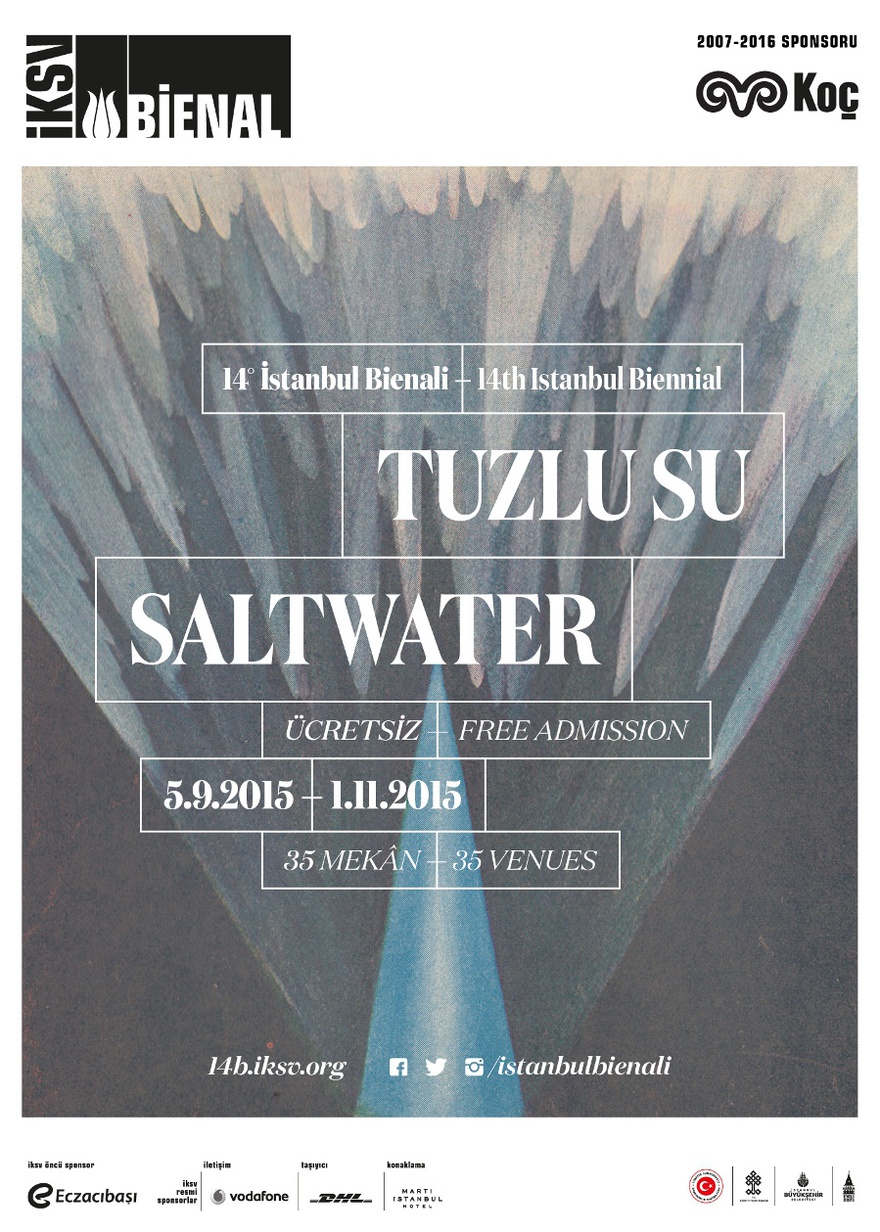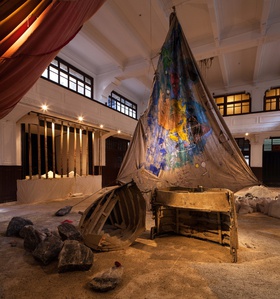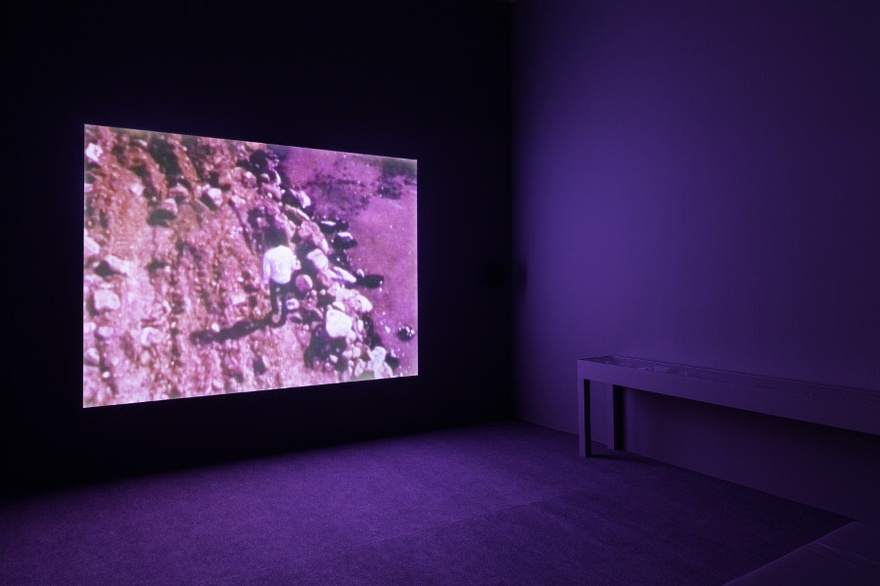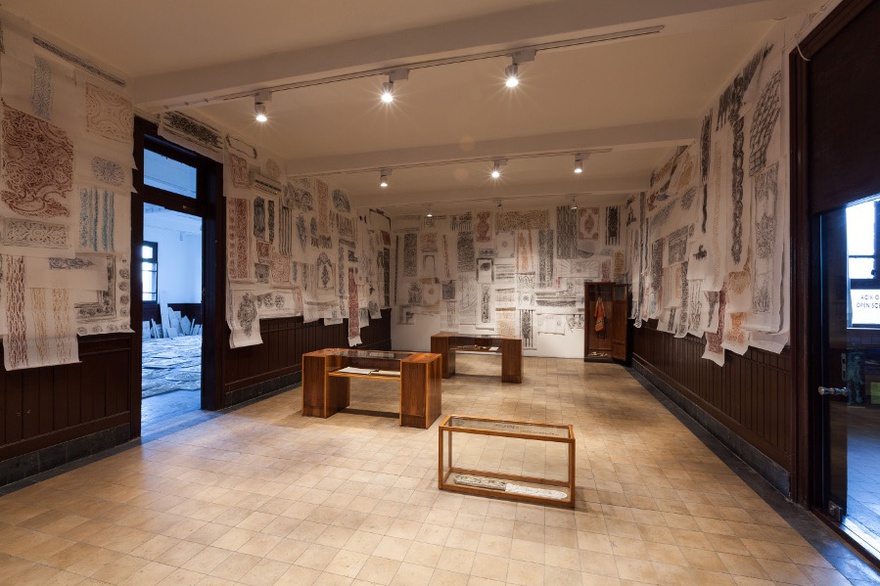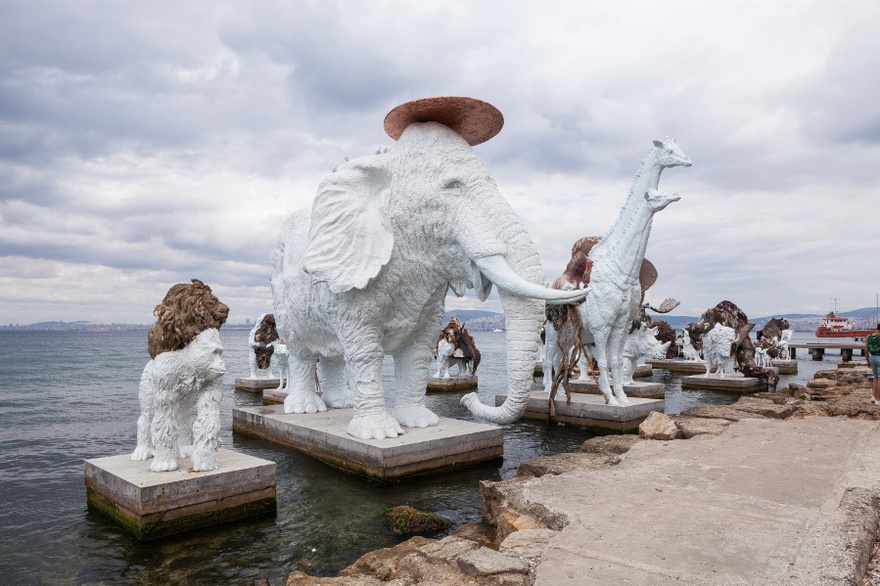Reviews
SALTWATER: A Theory of Thought Forms
The 14th Istanbul Biennial 2015
The 14th Istanbul Biennial is as broadly defined as it is integrated into the city. From the modern centre of Beyoğlu to a hamamı in the historical city; an artist studio in Kadıköy, to an island out in the Marmara Sea; then towards the northern part of the Bosphorus, SALTWATER: A theory of Thought Forms is bound together, according to 'organizer' Carolyn Christov-Barkargiev, by 'one of the most ubiquitous materials in the world'. Allusions to salt in accompanying literature celebrate salt's life-giving qualities; the sodium in the human body 'literally keeps us alive' – regular exposure to seas, oceans, straits, is beneficial to respiratory problems, and has a calming effect on nerves. Yet, as Christov-Bakargiev notes, salt water 'is [also] the most corrosive material threat to the digital age'. Drop your smartphone in water, we are told, and it can likely be repaired. In salt water, however, it stands little chance.[1]
Ubiquity might well speak to the conflicted politics of biennials currently, irrefutably caught between the homogenizing processes of neoliberal globalization and the movement against it.[2] Art's focus on rethinking the wrongs of history, democratic forms of representation, and inquiry into current social and political injustices is crucial as critical research practice. Yet, art's politics also suffer expediency, bound to an international event industry that – certainly in Istanbul – acts as catalyst for gentrification.[3] Istanbul is a good example of widespread discontentment with corporate funding structures, prompting repeated protests during the Istanbul Biennial in recent years.[4] Nonetheless, as sites of experimentation separate to the classificatory regimes of museums, biennials today retain contingency by refusing total absorption into the mechanisms of the historical canon. The latter, as far as I could make out, is part of this biennial's wager. Artworks possess the possibility to reshape viewers' attitudes by offering another way of seeing or, like the metaphor of salt, to corrode or vitalise.[5]
In many works, however, the relationship to the biennial's more central concepts proves ambiguous. A series of solo presentations are installed in temporary spaces around Beyoğlu. Theaster Gates, for example, occupies a building in Tophane, in which various and fragmented connections are made between his own work and Turkey. Thus, his ceramic practice becomes contemplation on Iznik pottery, a sophisticated earthenware production developed between the fifteenth and seventeenth centuries in western Anatolia. Like the presence and continuous playing of records released on Atlantic Records, founded by the Turk Ahmet Ertegun, the elements of Gates' practice are there to observe rather than to purchase, despite potential confusion in naming the workspace a 'store'. Elsewhere on Büyükada, the largest of the Prince's Islands about an hour's boat ride from the city centre, works such as Adrián Villar Rojas's The Most Beautiful of All Mothers (2015) are impressive. But just how much the life-size animal sculptures on the shores of Leon Trotsky's 1929–1933 dilapidated residence are related to the biennial's thematic – or indeed the contradictions implicit to the $4.4 million price tag attached to property – is unclear.[6]
More direct relationships to salt can be found at the Galata Greek Primary School, where Anna Boghiguian's large and beautiful installation narrates a history of salt traders, with painted maps on canvas sails hung within the school's first floor space, as a cutout of Obama and Erdoğan in an intimate embrace points to the implications of postcolonial trade agreements. At Istanbul Modern, the video part to Robert Smithson's Spiral Jetty (1970) is in-dialogue with Tacita Dean's more recent Salt (A Collection) (2013–14). Smithson's direct sculpting of sediments in the Great Salt Lake in Utah has been negotiated by Dean in a long term engagement with the ephemeral Spiral, resulting in a series of works speculating on the enigmatic anti-monument's resurfacing in memory, images, and film. The section named 'The Channel' on the Istanbul Modern's lower level, in which Dean's work appears, captures the biennial's ad hoc interdisciplinary character well. Walls painted in marine-like turquoise demarcate this area from the biennial's other more traditional white cube spaces. Sketches and notes by the psychoanalyst Jacques Lacan are mixed with Karl Blossfeldt's almost autoerotic photogravures; Song-Ming Ang's Something Old, Something New (2015) contemplates a nineteenth-century carved music stand, reproduced in glass and in drawing; an illustrated book by Charles Darwin sits in a glass vitrine. Mediation on the material trace – of which all visual material described here can be thought – 'speaks to an interior space (the exhibition)' which 'can create a different exterior (the world at large) in relation to itself'. Or so we read on Christov-Barkargiev's text panel before entering.
A helpful reference here might be Smithson's well-known writings and methods, particularly the 'site' and 'non-site' designating the world at large and the exhibition space respectively. For Smithson, convergences between his respective sites suggested the apprehension of multiple signs, a kind of discursive oscillation between one stage and another.[7] As Craig Owens put it: 'the spiral form of the Jetty is completely intuitable only from a distance, and that distance is most often achieved by imposing a text between viewer and work.'[8]
Yet, the absence of such citations does raise questions. Smithson's work made in the 1970s came at a moment when many artists from the USA began to blur art, writing, and curating.[9] The term 'curator' in this setting is to be used with caution however; Christov-Barkargiev prefers to reference her role in the 14th edition of this biennial as 'drafting'. In an interview with Flash Art published around six weeks prior to the opening, it was explained that:
'Drafting' is a word that is not used in the art world today and doesn't have the connotation of power that the word 'curating' has, which defines a job of advising art collections, selecting, dividing the good from the less good. It serves a productive function, and when you do that you become a functionary, an academic. You assert power, and I have negative associations with this sort of activity. This fundamental gesture of drawing and mark making came to my mind after looking at the Bosporus, which looks like a line drawn by a giant, connecting two seas.[10]
Refusal to convention might relate to the supposed contingency of biennial events referred to above. With some continuity to Christov-Barkargiev's dOCUMENTA (13) in 2012, during which 'agents' were recruited, advisors and assistants in Istanbul's drafting were referred to as 'alliances'. Negotiation, even rejection, of certain semantic associations can nevertheless prove problematic. dOCUMENTA (13) had 'no concept' – something TJ Demos described as both apt and unflattering. Demos also referred to the commissioning of 100 notebooks as outsourcing, perhaps complicating the 2012 exhibition in the current political economy more that Christov-Bakargiev had sought to.[11]
For Istanbul, however, loose concepts are offered: the saltwater of the Bosphorus, its 'waves' and 'knots' all inspire thoughts of biological systems and organic networks. In some respects, Christov-Bakargiev's distancing herself from prescribed roles is refreshing, coming at a moment when the figure of the curator takes centre stage in many equivalent events.[12] In others, evading proper and transparent reference to figures such as Smithson – despite resistance to functioning as an 'academic' – risks leaving her own methodology incomplete. Many questions are left unconfronted and unanswered.
For instance, 2015 marks the centenary of the 1915 Armenian massacre on Turkish soil. Claims that victims of death marches and famine amount to 1.5 million situate this atrocity as genocide, a figure and label the current government continues to deny.[13] Allusion to the centenary had been present in press releases leading up to the biennial opening. In what ways the exhibition would deal with the issue and other historical 'knots' was left, like much of the literature, generally elusive.
Francis Alÿs's work The Silence of Ani (2015), installed in the independent space Depo, reflected on the ruined medieval city of Ani, located near to the current Turkish border with Armenia. The video shows figures dashing through the city communicating with tone hole whistles that replicate birdcalls, as if memory of 'the city of 1001 churches' is echoed, although only partially legible, in the present. Haig Aivazian and the Beyoğlu Holy Trinity Armenian Church Choir echo their beautiful choral arrangement at various intervals through the Greek School. Michael Rakowitz, also showing at the former school, filled multiple spaces with plaster casts, rubbings, and other fragments taken from churches around Istanbul. In a vitrine, the history of Ani was also evoked in Rakowitz's sketches; a photograph in another shows the Armenian-owned Tokatlıyaz Hotel – in a text written on the glass over the image, the artist tells us that the building was heavily damaged in 1915 during the Armenian Genocide. Rakowitz's was the only direct use of the latter term that I could see. Ayreen Anastas and Rene Gabri's Society of the Friends of Parrhesia initiated a residency in the former offices of the Turkish/Armenia weekly Agos. Over the two months of the biennial the space will be used to hold discussions and informal seminars, many likely to be organized around their discoveries as they sort the archive of the late chief editor Hrant Dink who was tragically assassinated in 2007 on the building's doorstep.
The above works do represent the more progressive parts of this biennial, as well as the impressive number of newly commissioned works for 2015; other spaces open to dialogue included Fernando García-Dory's economic and socially focused INLAND Türkiye Extension Agency in the Cezayir Building meeting rooms. Openness to process and artistic freedom does reflect Christov-Bakargiev's style. But again, just how convincingly the framework ties together in this the cacophony of works is worth asking.
The 2015 edition apparently came up against no censorship issues, even if it did approach the Armenian issue. Surprising, given the sensitivity of the topic in Turkey and the exhibition's history of enforced omissions.[14] At the same time, however, works that confronted the centenary of the ethnic cleansing in any direct way were largely absent. And references, like Rakowitz's, to the term genocide were well hidden. On 24 April this year, thousands gathered in Istanbul to commemorate the tragic events 100 years earlier. The government's decision to move centenary commemorations of the World War I Ottoman military victory on the Gallipoli peninsula one day forward from 25 to 24 April represent only partially the lengths the Turkish state have moved to eclipse the humanitarian atrocities of 1915.[15] Yet international attention prompted by such cover-up attempts can often inadvertently attract the sort of publicity intended to be avoided. Mixed with intolerances towards media provocation and free speech – Turkey's incarceration of dissident journalists, for example, is on going[1] – it might also be asked whether absence of direct confrontations of the centenary in 2015 worked as a kind of Foucauldian act of self-censorship, or if it was just a matter of playing it a little safe.[17]
Given such precautions, perhaps a better way to frame the biennial would have been through storytelling; for example, to bring Boghiguian, Smithson, Alÿs, Rakowitz, and even Darwin together in a more salient way. Although 'thought forms' is open to much interpretation, mediations on the politics of storytelling were available in many places. Take as another example Esra Ersen's documentary-fiction work installed in the Italian High School, tracing the founding of the 1923 Turkish Republic in relation to Atatürk's experience of Bulgarian culture and history. Here, narrators reflect poetically on historical events via reference to found archive materials projected on two screens. Distinctions between compositions of history and fiction in related discourse are often distorted as if to insist their inseparability. After all, the method of censorship on 24 April was more an attempt to occupy a discursive space rather than straightforward restriction; something many of the works dealing with Armenia and other histories could be said to do in various and productive ways. Although some works dealing with speculative discourses could be described as evident in Christov-Bakargiev's notion of 'drafting,' necessary criticality in the framework is lacking and fails to bring together such artistic maneuvers adequately or with any urgency.
Where artists such as Anastas and Gabri are given the space and time to produce a situation with real political currency, the curatorial framing of the 14th Istanbul Biennial can hardly be said to convincingly represent their research initiative. Christov-Bakargiev's anti-curatorial strategy does negotiate parts of the all-too pervasive curator-egos of recent times and, in this, anti-conservativism is welcomed. On the other hand, ill definition of her declared interdisciplinarity, evident in the allusion to drafting, only drifts and wavers and is in the end too evasive. No clear political position is taken. Salt as a metaphor is so open-ended that almost any interpretation, alongside any work, could be vaguely argued. Without necessary self-reflexivity, the metaphor's relationship to the role of artists and the politics of works exhibited verges of the arbitrary and noncommittal. In that, the 14th Istanbul Biennial risks simply reproducing a representative crisis in current day bipartisan politics of many institutions.
[1]See Carolyn Christov-Bakargiev, 'Preface' in SALTWATER: A Theory of Thought and Forms, ed. Süreyya Evren (Istanbul: Istanbul Foundation for Culture and Arts, 2015), pp. xxiv-xxv; also, Carolyn Christov-Bakargiev's texts included in media material, available at: http://14b.iksv.org/media.asp#english
[2]See, for example, Paul O'Neil, The Culture of Curating and the Curating of Culture(s) (Massachusetts: The MIT Press, 2012), pp. 51-85.
[3] See, for example, Beral Madra, 'The Hot Spot of Global Art: Istanbul's Contemporary Art Scene and its Sociopolitical and Cultural Conditions and Practices,' in Third Text 22.1 (2008): pp. 105-112; also, Banu Karacu, 'When Duty Calls…: Questions of Sensitivity and Responsibility in Light of the Tophane Events,' in Red Thread 3 (2011): http://www.red-thread.org/en/article.asp?a=49.
[4] Most prominently in recent times were the 2009 and 2013 biennials, both concurrent with significant anti-governmental/capitalist urban protest movements at the time. See, for example, Gail Day et al., '"What Keeps Mankind Alive?": the Eleventh International Istanbul Biennial. Once More on Aesthetics and Politics,' in Historical Materialism 18 (2010): pp. 135-171; also Tom Snow, '13th Istanbul Biennial: A Retreat to the Institution,' in Afterall (2013): http://www.afterall.org/online/13th-istanbul-biennial-mom-ami-barbarian/#.VeRBoNOqqko. Notable examples beyond Istanbul include The Sydney Biennial and Manifesta in St. Petersburg, both 2014.
[5] Again, this is present in much of the accompanying biennial literature, as well as the opening press conference on 2 September 2015. See also, Halil Antındere and Süreyyya Evren, 'Interview with Carolyn Christov-Bakargiev, Istanbul Biennials and Cherishing Life on the Planet,' in User's Manual: Contemporary Art in Turkey 1975-2015, eds. Halil Antındere and Süreyyya Evren (Istanbul: art-ist, 2015), pp. 207-211.
[6] Marga Zambrana, 'All property is theft but this one's a steal: Leon Trotsky's Turkish hideaway for sale,' in The Guardian, 8 August, 2015, http://www.theguardian.com/world/2015/aug/08/leon-trotsky-turkish-island-hideaway-property-sale.
[7] In a note accompanying his essay on the Spiral Jetty, the artist explains: 'The range of convergence between Site and Nonsite consists of a course of hazards, a double path made up of signs, photographs, and maps that belong to both sides of the dialectic at once. Both sides are present and absent at the same time'. See Robert Simithson, 'The Spiral Jetty' (1972) in, Robert Smithson: The Collected Writings, ed. Jack Flam (Oakland, CA: University of California Press, 1996), p. 153.
[8] Craig Owens, Beyond Recognition: Representation, Power and Culture (Oakland, CA: University of California Press, 1992), p. 47.
[9] Any number of examples would suffice here, from Robert Morris to Donald Judd, to Mel Bochner's Working Drawings and Other Visible Things on Paper Not Necessarily Meant To Be Viewed as Art (1966).
[10] 'Carolyn Christov-Bakargiev on the 14th Istanbul Biennial,' in Flash Art (2015): http://www.flashartonline.com/2015/07/carolyn-christov-bakargiev-on-the-14th-istanbul-biennial/.
[11] TJ Demos, 'Gardens Beyond Eden: Bio-aesthetics, Eco-Futurism, and Dystopia at dOCUMENTA (13),' in Brooklyn Rail (2012), available at: http://www.brooklynrail.org/2012/10/art/gardens-beyond-eden-bio-aesthetics-eco-futurism-and-dystopia-at-documenta-13.
[12] Since at least Catherine David's 1997 Documenta, the curator has taken centre stage in perennial events.
[13] See, for example, Kerem Öktem, Turkey since 1989: Angry Nation (London and New York: Zed Books, 2011), pp. 14-55.
[14] For example, Istanbul-based artist Burak Delier's photograph Guard (2005) was censored from the 9th edition in 2005 (entitled simply İstanbul by curators Vasif Kortun and Charles Esche), for reasons, according to critic Süreyyya Evren, that aren't entirely clear; see, Süreyyya Evren, 'Parrhesiatic Games in Turkish Contemporary Art Scene,' in Third Text 22.1 (2008), p. 42.
[15] See, for example, Constanze Letsch, 'Turkey eclipses centenary of Armenian massacre by moving Gallipoli memorial,' in The Guradian, 16 April 2015), http://www.theguardian.com/world/2015/apr/16/turkey-armenia-1915-centenary-gallipoli-massacre-genocide.
[16] Examples of the Turkish government's intolerance to media provocation abound. To give just a couple of recent examples, incarceration of the Iraqi journalist Mohammed Ismeal Rasool for using encryption software whilst working with Vice News whilst researching in Diyarbakir is on going, see, http://www.aljazeera.com/news/2015/09/turkey-british-vice-news-journalists-150903112845075.html. The offices of Turkish magazine Nokta were also raided in September for relapsing a mocked-up picture of President Erdoğan taking a selfie in front of a coffin of a soldier, recalling Peter Kennard and Cat Phillipps' image of Tony Blair taking a selfie in front of an air raid landsape linked to the 2003 Iraq invasion, see, http://uk.reuters.com/article/2015/09/14/uk-turkey-media-idUKKCN0RE1AK20150914
[17] By Foucauldian act of self-censorship I mean to indicate what Michel Foucault described as the internalisation of power structure. That is, the presence of certain laws and social orders becoming part of standardised social behaviours. Self-censorship here would describe the conscious behaviour of caution, not doing something in fear of the consequences. See, for example, Michel Foucault, Discipline and Punish: The Birth of the Prison, trans. Alan Sheridan (London: Penguin, 1977).

